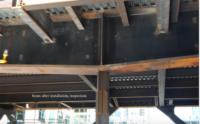L.A. Gives Notice to Owners of Older Concrete Structures About Seismic Retrofits

In Chile, a nonductile concrete building was damaged in an earthquake and then razed. Los Angeles’ seismic retrofit law could apply to 1,200 buildings, but about half are no more than two stories.
PHOTO COURTESY APPLIED TECHNOLOGY COUNCIL
Earlier this month, just over two years after Los Angeles passed a law requiring seismic retrofits of older, nonductile concrete buildings, the city’s Dept. of Building and Safety began sending compliance orders to owners. The L.A. retrofit ordinance, which also includes requirements for weak first-story wood-framed buildings, was the first of its kind in the U.S.
The buildings department expects the ordinance’s nonductile concrete sections, which give owners 25 years to retrofit or raze, to apply to some 1,200 buildings. To date, though more may be listed, “the majority of the buildings have been identified,” says Luke Zamperini, chief inspector and public information officer for the buildings department.
The list is based on information from the University of California, Berkeley, and the Los Angeles County Assessors’ Office. In addition, the buildings department searched its records, reviewed available plans and made site inspections.
In the L.A. Municipal Code, Ordinance No. 183893, Article 1, Division 95, named “Mandatory Earthquake Hazard Reduction in Existing Non-Ductile Concrete Buildings,” applies to any existing concrete building, other than freestanding one- and two-family houses, that had a permit application before Jan. 13, 1977. If no permit can be found, the department determines the structure’s age.
The ordinance has three key compliance dates, says Zamperini. Within three years of the order to comply, a California- licensed civil or structural engineer must submit a checklist to the city. The checklist must be approved by the department’s unit for nonductile concrete retrofits.
Within 10 years of the order date, the owner must submit a structural analysis that shows the building complies with the retrofit ordinance or submit a structural analysis and plans for the alteration of the building to comply with the retrofit ordinance or submit plans for the building’s demolition. Within 25 years of the order date, owners must complete all necessary demolition or retrofit work.
For an exemption, a structural analysis must show the strength of the lateral-force-resisting system meets or exceeds 75% of the base shear specified in the current code. At least one engineer says 75% is an arbitrary percentage.
The city has not calculated the total square footage involved. But in a city of some one million buildings, 30%, or 400, of the buildings on the list have one story and 23% have two stories, says David Bonowitz, a structural engineer who consults to several Bay Area cities. Bonowitz says one-story buildings are “likely” not even at risk unless clustered.
The ordinance grew from the city’s resilience program. Bonowitz thinks city resilience funds could be better spent on worse threats. Beyond that, a resilience plan should look at the stock by occupancy and cross-reference that to vulnerable structure types, he says.
Age shouldn’t matter. “A resilience plan should be about severely deficient new and existing occupancies,” adds Bonowitz.
There are other objections. Daniel Zepeda, a principal with Degenkolb Engineers, thinks it would be better to use the American Society of Civil Engineers’ seismic retrofit standard, known as ASCE 41, rather than the L.A. code.
The ASCE standard, which gets updated, offers “better ways to evaluate and retrofit a building than the current L.A. code because it accounts for all the nonductile elements,” says Zepeda.
Michael Cochran, a vice president of Thornton Tomasetti, adds, “This is a 25-year project. They have got to allow use of the most current document.”
Zepeda supports a phased program. In nearby West Hollywood, for example, the most deficient buildings must be fixed within 10 years and the rest within 20.



